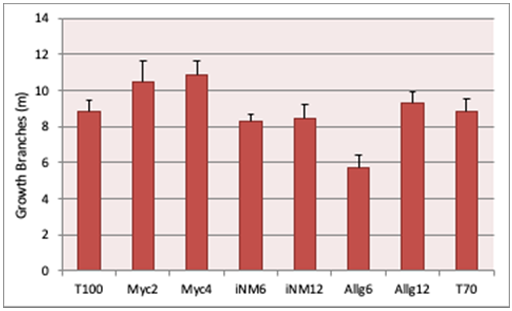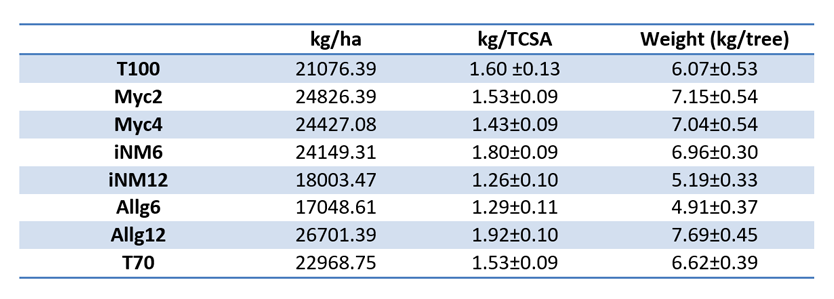Biofertilizers are formulations that contain live microorganisms, usually bacteria and/or fungi, which establish symbiotic relationships with host plants and can bring a range of benefits to agricultural production. Among the most important benefits are the greater availability of nutrients in the soil thanks to the added fixation of nitrogen (e.g. Azotobacter, Rhizobium), the solubilisation of phosphorus (e.g. Bacillus subtilis and Bacillus megaterium), sulphur (e.g. Thiobacillus) or potassium (e.g. Bacillus mucilaginosus), increasing its content in the soil and/or biological availability. They can also interfere in the production of phytohormones, affecting plant growth and structure, as well as root size, in the biological control of soil diseases, biodegradation of substances, recycling of nutrients and bioremediation of contaminated soil.
To assess the potential effects of biofertilizers on the increased productivity, quality and physiological response of the plants and the possibility of reducing the fertilizer units applied by conventional technology, an experimental protocol was established between INIAV, I.P. and Asfertglobal. The main results are briefly described herein. To carry out the assessments, in May 2018, an orchard of branched apple trees (7+) of the “Gala Redlum” apple variety was planted, grafted on M9, with 3472 trees per hectare (3.20×0.90). The rows treated with biofertilizers were fertilized with 70% of the units used in the standard programme and compared to the 70% control lines (T70) and 100% control lines (T100) of the programme (with no biofertilizer applied). The effects of three biofertilizers were assessed, namely of Mycoshell® (a combination of Glomus spp. endomycorrhizae with humic and fulvic acids) in doses of 2 (Myc2) and 4 tablets (Myc4) applied at plantation, Kiplant All-Grip® (Bacillus megaterium – 1 x 10 * 8 cfu/ml) in doses of 6 (Allg6) and 12 l/ha (Allg12) and Kiplant iNmass® (Azospirillum brasilense – 1 x 10 * 8 cfu/ml), in doses of 6 (iNM6) and 12 l/ha (iNM12), applied at the start of the cycle.
The application of the biofertilizers led to an increase in the leaves’ nitrogen content, with average values of the analyses carried out in the first two years higher than the control group treated with the same fertilizer units (T70) and in most cases equivalent to or higher than the control group with the standard programme (T100). Increased phosphorus and magnesium content was also noted, which was faster in the Myc2 and Allg12treatments, with most of the biofertilizer treatments at the end of the second year presenting higher phosphorus content on the upper leaves than both control groups (T70 and T100) and higher than the T70 group for magnesium. No noteworthy effects have yet been observed for potassium and calcium. The application of the biofertilizers also seems to have consequences on the copper, manganese and sodium content in the soil and sulphur, boron and zinc in the leaves.
The analysis of the growth of the trunk and branches of the trees submitted to the different strategies brings to light notable differences. The final height of the trees after the first two years of the trial was greater in the control T70 (2.33m), although the differential in this period was greater in T100, followed by iNM12, Allg12 and iNM6, all with growth higher than T70 (26cm). The TCSA (trunk cross-section area) increased more in the trees treated with Mycoshell® (Myc4 +2.86 cm2 and Myc2 +2.57 cm2) and iNM12 (+2.59 cm2), above the control T70 (+2.52 cm2) (Figure 1). As for the formation of new branches in the trees, at the end of the second year after they were planted, the groups treated with Mycoshell® had 15.61 (Myc2) and 15.23 (Myc4) metres of branches per tree, which was an increase of 10.87 and 11.14 metres per tree formed after the installation, higher than the biofertilizer trees treated with Allg12 (9.60 metres per tree) and control T70 (8.99 metres per tree) (Figure 2). This means that during this period the most favourable biofertilizer treatment (Myc4) produced 7.47 km more branches per hectare than the control group with the same fertilization. The weekly fruit growth was also greater for all the biofertilizer treatments, apart from Allg12.


Figures 1 and 2 – TCSA (cm2) and average accumulated length of the branches (m) of trees with and without biofertilization (2018-2019)
During the plantation year, there was also a noticeable effect of the biofertilizers on the bud breaking of the dormant buds located at the level of the early branches, which is important to offset the weakening of these branches in the zone nearest the axis and to better distribute the load in the branch in the following years. Myc2 (38.5%) (despite the high growth of the branches in this year [+3.39m]), and Allg6 (41.8%) provided higher bud breaking rates, in contrast to the control T100 (26.3%).
Analysis of the CCI (Chlorophyll Content Index) is an indirect and non-destructive method of obtaining estimates of the chlorophyll content, thus inferring the physiological performance of the plant. In the first two years, the biofertilizer treatments presented higher CCI numbers than the control T70 for most of the measurements. The Allg12, Myc4 and iNM6 treatments stood out, with the Allg12 treatment providing higher numbers in all the eight measurements made (four annually). The values obtained were higher than those obtained in the control T100 in some of the periods analysed.
Albeit without statistical significance, all the treatments apart from iNM12 and Allg6 presented photosynthesis rates higher than control T70 (12 µmol m-2s-1), with the highest rates reached by the iNM6 (13.72 µmol m-2s-1) and the Allg12 treatments (13.10 µmol m-2s-1). These differences will have an essential impact on tree production.
The calculation of the SLA (specific leaf area) showed that the trees treated with biofertilizers returned more favourable values (lower – thicker leaves) than the control T70 trees for the first year and for most of the period analysed in the second year, with the Allg12 and iNM6 treatments especially noteworthy.
By analysing the fluorescence through OJIP tests, the maximum quantum yield potential of the PSII (Fv/Fm) and the performance index were assessed, expressed on the basis of the absorption (PIabs), since they are two indicators which are very closely related to the physiological performance of the plants. Fv/Fm is one of the most commonly used fluorescence measures to detect the vitality of the PSII (Photosystem II) and to measure the plant stress. On 13 June, when the temperature and moisture stress conditions began to intensify, the biofertilizer treatments, apart from Allg6, presented higher values than the control T70 and on 1 August all of them led to higher numbers. It should be noted that all the treatments returned very conservative efficiency values that indicated the absence of physiological stress, with little differences among one another. The PIabs is a multiparameter expression calculated as a function of the main photochemical processes, like the absorption and capture of excitation energy, transport of electrons and dissipation of surplus energy. On 13 June, the biofertilizer treatments, apart from Allg6, presented higher values than the control T70 and on 1 August, apart from the Myc2 and iNM6 treatments, all continued to present better indicators despite the fact that in the post-harvest only the iNM6 treatment had a better performance.
Among the reflectance parameters analysed, we point out the NDVI (Normalized Difference Vegetation Index) as the most widely known. It is an index that gives us a standardised measure of plant vitality, often used to estimate biomass, LAI, moisture stress, among others. In the measurement made on 13 June, apart from the Myc4 treatment, all the biofertilizer treatments led to values in the leaves higher than the control T70; these differences were reversed in the following measurements where only the biofertilizer trees treated with Allg12 led to higher NDVI values. However, it should be noted that these differences were never higher than 3.5%.
The production obtained showed the Allg12 treatment to be the most productive, with 16.2% more than T70 and higher than T100. Likewise, the Mycoshell® treatments (Myc2 with 8% more and Myc4 with 6.3% more) and iNM6 (5.1%) produced more. iNM12 and Allg6 produced less than the other treatments (Table 1).

The productivity levels obtained should be highlighted, as the Allg12 treatment presented 26.7 t/ha compared to 22.9 t/ha of the control T70 and the other three treatments (Myc2, Myc4 and iNM6) produced more than 24 t/ha. These figures, when standardised with the TCSA, show the Allg12 and iNM6 treatments to be the most efficient.
Analysing the number of fruits per tree showed that the trees treated with Myc2 produced more fruits (59.80), followed by
the trees treated with Allg12 (59.50), while all the other categories produced fewer fruits than control T70 (51.70). Indeed, Myc2, Myc4, Allg12 and T70 produced significantly more than the iNM12 and Allg6 treatments.
With the exception of the Myc2, Allg12 and T70 treatments, for which the 60-65 and 65-70mm caliber classes predominated, in all the other categories the 65-70 and 70-75mm classes predominated. In the T100, Myc4 and iNM12 treatments, the 70-75mm caliber class predominated. The T70 and Myc4 treatments were the ones that led to the highest percentage of calibers lower than 60mm (>20%).




To assess the differences in root growth and respective consequences in the above-ground part, “Gala Redlum” variety apple trees (3+), grafted on M9, were planted in 33l-pots with substrate, comparing the control trees with no biofertilizer application against the Myc2, iNM6 and Allg6 treatments. Although part of the fine roots was strongly absorbed in the substrate, which made it difficult to segregate it, the control plants invested more in the main root (longer) and less in the secondary and tertiary roots. In this regard, it was observed that all the trees treated with biofertilizers had a higher number of thick roots (more branching), with the Allg6 treatment standing out with an average of 9.67 roots per plant and a total root weight of 232.98 g, which corresponds to a root density of 0.007 g/cm3. Myc2 and iNM6 also presented a higher number of branches, although this was not reflected in the total weight of the roots, which could mean greater investment in fine roots

The effect of the biofertilizers was more noticeable in the greater development of the above-ground part, whereby the plants treated with iNM6 presented the greatest total weight, followed by those treated with Allg6 and Myc2. These categories showed an even longer trunk length and higher total weight of the branches. The iNM6 and Allg6 treatments presented a higher number of branches than the control group

In the current production models, it is essential to re-establish the soil-plant balance, offsetting the negative effects caused by the diminishing animal production (and consequent reduction of indispensable organic fertilization), excessive application of herbicides and exploitation of the production potential, necessary for the economic sustainability of the farming operations. Biofertilizers can help improve the biological activity of the soil, boosting the biological control of pathogenic organisms, reducing the contamination of the soils and water and increasing the fertility of the soils and productivity of the crops with fewer fertilizer units applied.
Rua Nova da CEE, Perofilho
2005-008 Várzea, Santarém
Portugal
Tel.:+351 243 779 431
info@asfertglobal.com
Edificio “Palmera Center”, C/ Historiador Juan Manzano, S/N, 1ª Planta, Oficina 31, 41089 Condequinto – Sevilla
España
Telf.: +34 954 12 86 15
info@asfertglobal.com
Unit 58 Zambezi Junction, Zambezi
Road Montana, Pretoria 0159
South Africa
Tel.: +27 843 455 286
werner@asfertglobal.com

<span>Italy</span>
Headquartered in Santarem, we are currently present in more than 35 countries.
For more information contact us.
Enhance your production with our tips and news directly in your email